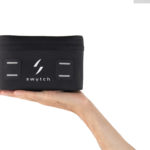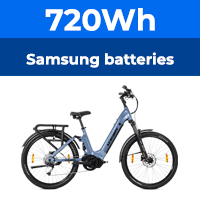Hi everyone just testing my yose battery for milage I'm 11 stone only have a few hills to get up mostly just inclines been on number 2 eco mode and the odd number 3 now and again my battery is 36v 13 amp so far I'm at 32 miles and it's down one notch to 38.4 just wondering what sort of mileage it will do, I know the warmer weather will help at the moment.
Yose miles
- Thread starter detec52
- Start date
So 36V 13A battery = 468Wh
Legal pedal assisted e-bikes typically use between 5Wh per mile for very light assistance to 20Wh for more substantive assistance, so depending on rider weight, terrain, speed and assistance the range is likely to be between 90 miles for very light assistance to 23 miles for lots of assistance.
I converted a folding bike with a 36V 10A battery - 360Wh. Using light-moderate assistance in reasonably flat terrain I am getting round about 45 miles range
Legal pedal assisted e-bikes typically use between 5Wh per mile for very light assistance to 20Wh for more substantive assistance, so depending on rider weight, terrain, speed and assistance the range is likely to be between 90 miles for very light assistance to 23 miles for lots of assistance.
I converted a folding bike with a 36V 10A battery - 360Wh. Using light-moderate assistance in reasonably flat terrain I am getting round about 45 miles range
Last edited:
How far you go depends on how hard you pedal. I can get anywhere between 15 miles and 129 miles on the same journey with a 700wh battery.Hi everyone just testing my yose battery for milage I'm 11 stone only have a few hills to get up mostly just inclines been on number 2 eco mode and the odd number 3 now and again my battery is 36v 13 amp so far I'm at 32 miles and it's down one notch to 38.4 just wondering what sort of mileage it will do, I know the warmer weather will help at the moment.
If you got 38.4 miles and your battery's resting voltage was 38.4v, and you carry on riding on the same ride and pedalling equally as hard, you'll get about another 15 to 20 miles from the battery. Don't forget that the power goes down as your battery empties, so you're going to have to pedal much harder to get up any hills.
Surely he'll get more than that ? 42V to 38.4V = 3.6V voltage drop 38.4V- 30V 8.4V voltage drop - I thought he was less than halfway through his battery ?If you got 38.4 miles and your battery's resting voltage was 38.4v, and you carry on riding on the same ride and pedalling equally as hard, you'll get about another 15 to 20 miles from the battery. Don't forget that the power goes down as your battery empties, so you're going to have to pedal much harder to get up any hills.
It's the resting voltage. The running voltage would be about 1v lower, then you have to consider sag when you draw power, and lastly, the voltage starts to accelerate downwards once you get past about 35v. Also, say you have a 15A controller running at about 7A. When full, you'll be getting 7 x42 = 294 watts. When the battery is down to 34v, you get 7 x 34 = 238w. To get the same power as you had before and pedal the same, you'd have to select a level higher to get the 8.6A needed. In other words, not only is the battery going down faster by itself, but you'll be demanding higher current from it, so it goes down even faster.Surely he'll get more than that ? 42V to 38.4V = 3.6V voltage drop 38.4V- 30V 8.4V voltage drop - I thought he was less than halfway through his battery ?
Of course, just to prove a point, you could turn down the power, use lower gears to go slower and pedal harder and last the battery for another 100 miles. I make an explanation for how it works. It's up to you what you do with it.
I was just surprised that resting 38.4V was only 1/3 -1/4 useful battery power leftIt's the resting voltage. The running voltage would be about 1v lower, then you have to consider sag when you draw power, and lastly, the voltage starts to accelerate downwards once you get past about 35v. Also, say you have a 15A controller running at about 7A. When full, you'll be getting 7 x42 = 294 watts. When the battery is down to 34v, you get 7 x 34 = 238w. To get the same power as you had before and pedal the same, you'd have to select a level higher to get the 8.6A needed. In other words, not only is the battery going down faster by itself, but you'll be demanding higher current from it, so it goes down even faster.
Of course, just to prove a point, you could turn down the power, use lower gears to go slower and pedal harder and last the battery for another 100 miles. I make an explanation for how it works. It's up to you what you do with it.
30v imv is a bit too low to take a 36v battery , typically for better life I would look at 34v as a min voltage. Sag will be noticable as voltage decreases and esp inclines will not do the battery any favours at lower voltage.
Flatter terrain and it is a different story.
Flatter terrain and it is a different story.
30v imv is a bit too low to take a 36v battery , typically for better life I would look at 34v as a min voltage. Sag will be noticable as voltage decreases and esp inclines will not do the battery any favours at lower voltage.
Flatter terrain and it is a different story.
Well I used my bike mainly in 2 eco mode and the odd 3 and 4 setting for long inclines got up to 46 miles with 35.3v still on the clock so I'm well pleased with that figure obviously it won't be as good as that in winter but I only do short runs in the colder months so no problem.
Related Articles
-
 Swytch announce new conversion kit with ‘pocket-sized’ battery
Swytch announce new conversion kit with ‘pocket-sized’ battery- Started by: Pedelecs
-
 New Swytch launches on Indiegogo, raises £100k in first hour
New Swytch launches on Indiegogo, raises £100k in first hour- Started by: Pedelecs
-
 Swytch to unveil 70% smaller, 50% lighter conversion kit
Swytch to unveil 70% smaller, 50% lighter conversion kit- Started by: Pedelecs


